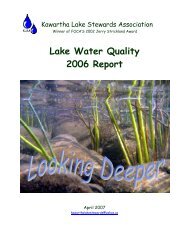Phosphorus and the Kawartha Lakes - Lakefield Herald
Phosphorus and the Kawartha Lakes - Lakefield Herald
Phosphorus and the Kawartha Lakes - Lakefield Herald
You also want an ePaper? Increase the reach of your titles
YUMPU automatically turns print PDFs into web optimized ePapers that Google loves.
Conclusion<br />
The majority of <strong>the</strong> archived data <strong>and</strong> subsequent analyses used in this chapter<br />
suggest that phosphorus levels have declined in <strong>the</strong> <strong>Kawartha</strong> <strong>Lakes</strong> watershed, which is<br />
congruent with <strong>the</strong> finding of Robillard <strong>and</strong> Fox (2006); however, <strong>the</strong> results should be<br />
interpreted cautiously. There is evidence that phosphorus levels are closely linked with<br />
precipitation patterns, where wet years have higher phosphorus concentrations than dry<br />
years (Novotny <strong>and</strong> Olem, 1994). According to Environment Canada <strong>the</strong> <strong>Kawartha</strong><br />
<strong>Lakes</strong> area had a much higher average rainfall in 1972 than it did in ei<strong>the</strong>r 1976 or 2005.<br />
Similarly, 1976 had a higher average rainfall in 1976 than it did in 2005; however, it is<br />
ostensible that phosphorus levels have been decreasing over time. Fortunately, <strong>the</strong> datum<br />
from Sturgeon Lake was collected annually <strong>and</strong> demonstrates a clear decreasing trend in<br />
phosphorus concentrations over time (Figure 5.3). It would appear that phosphorus<br />
concentrations have remained relatively stable in Sturgeon Lake from 1988 through to<br />
2005 at approximately 17 µg/l.<br />
Finally, <strong>the</strong> results au<strong>the</strong>nticate that lake phosphorus concentrations increase as<br />
water flows East through <strong>the</strong> lake continuum from Balsam Lake to Lovesick Lake. The<br />
increasing logistic pattern is <strong>the</strong>n disrupted as phosphorus poor water enters <strong>the</strong> system<br />
from Upper Stony Lake <strong>and</strong> dilutes <strong>the</strong> phosphorus rich water of Lovesick Lake below<br />
Burleigh Falls in Lower Stony Lake. The lakes’ phosphorus concentrations continue to<br />
increase after dilution at Lower Stony Lake as demonstrated by <strong>the</strong> successively higher<br />
phosphorus concentrations in Clear <strong>and</strong> Katchewanooka <strong>Lakes</strong>.<br />
Take Home Message<br />
<strong>Phosphorus</strong> levels have declined approximately 7 µg/l over <strong>the</strong> past 20 years <strong>and</strong><br />
are currently around 14 µg/l. <strong>Phosphorus</strong> concentrations are known to increase in wet<br />
years <strong>and</strong> decrease in dry years: 2005 was a dry year. <strong>Phosphorus</strong> concentrations<br />
increase as water flows from Balsam Lake along <strong>the</strong> Trent Severn Waterway to Rice<br />
Lake. There is a slight dilution <strong>and</strong> resultant reduction in phosphorus concentration as<br />
phosphorus poor water enters <strong>the</strong> system from Upper Stony Lake via Lower Stony Lake<br />
(Figure 5.4).<br />
22





